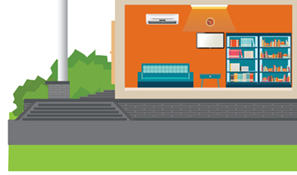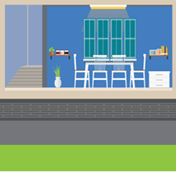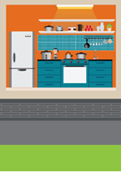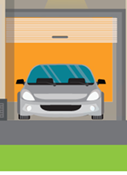Attic, Garage and Insulation
Your attic, garage and basement are the main areas where insulation can improve your home’s energy efficiency. Look below for helpful tips to reduce the electricity bill by properly insulating these areas.
Office and Electronics
In this digital age, electronics are found in every room of the house and many of them have energy-efficient settings. Check out our list below for more information.
Bedroom
Even while you sleep, your home can still use energy. Below we have outlined some tips on saving electricity and staying comfortable without breaking the bank.
Bathroom
This may not be a hot spot for energy efficiency, but there are ways to conserve energy without sacrificing comfort. Check those out below.
Living Room
From lighting to windows to your thermostat, the living room is a great place to make the most out of home energy savings. Read on to see how to reduce electricity bills in your main living space.
Miscellaneous
There are many more ways you can save energy that don’t necessarily fit into one particular room. We have you covered with more tips below.
Kitchen
Even with energy-efficient appliances, you can still learn how to save money on electric bills with the helpful tips you’ll find below.
HVAC – Heating, Ventilation and Air Conditioning
The majority of your energy usage comes from your HVAC system. Below we have outlined numerous tips to help you stay comfortable and maintain your system while lowering your utility bills.
A PLAN TO CONSERVE ENERGY AND LOWER UTILITY BILLS CAN START ANYWHERE, ANYTIME
As your trusted energy partner, OPPD wants to empower you to take control of your energy use. This interactive floor plan lets you choose where you would like to start your journey toward a more energy-efficient way of living – and a lower electricity bill.
-
Attic, Garage and Insulation
Wondering how to save money on electricity bills? It starts with insulation throughout your home – especially in the attic. Insulation is measured by R-value: The higher the value, the better the insulation is at preventing the flow of heat from space to space. Follow these tips for conserving energy.
- Check the insulation in your attic, ceiling, exterior and basement walls, floors and crawl spaces to ensure it meets the local energy code recommended levels.
- Seal any gaps before adding or replacing insulation.
- Insulate any cold or hot water lines that are in unconditioned spaces.
- Be sure to insulate rim joists using batt or rigid foam board insulation.
- Insulate the attic hatch by using batt insulation and by adding weatherstripping where the hatch meets the frame.
- If your garage has an unfinished ceiling to a living space above, seal all possible sources of air leakage before insulating and finishing. This helps minimize the danger of potential garage contaminants entering the living space.
- Install weatherstripping on windows and exterior doors, including the door to an attached garage.
- Consider installing plastic window covering on drafty windows.
- Apply caulk or spray foam to band joists, rim joists (the area which goes around the top perimeter of your basement) and other structural component gaps.
- Install outlet and switch plate foam gasket seals on exterior outlet and switch panels.
-
Bathroom
Don't let utility bill costs go down the drain! Keep these energy savings tips in mind when in the bathroom.
- Set your hot water heater to 120 degrees instead of 140. Doing so can lower your utility bill by 6%-10%.
- Install LED bulbs in your vanity and the rest of the bathroom. Switching from incandescent to LED can lower the energy usage by 60%-80%.
- Leaving the water running while brushing your teeth can amount to 4-5 gallons of unused water down the drain.
- High-efficiency, low-flow showerheads and faucets save on hot water usage and often have no resulting loss of comfort.
- Newer, more efficient showerheads can reduce the water use from approximately 5 gallons per minute to 2.5 gallons per minute.
- Only use the bathroom exhaust fan when absolutely necessary. It not only consumes energy, but also can suck conditioned air out of your home.
-
Bedroom
Your home consumes energy around the clock. Learn how to save on the electric bill even when you're sleeping.
- Fans cool people, not rooms. Consider raising the temperature of the thermostat in the summer and using a fan to help cool you off as you sleep.
- Lower the thermostat in the winter with the help of ceiling fans on low and spinning clockwise to help distribute warm air more evenly in a room.
- Blackout curtains can not only help you sleep better, they can also help block the heat from the sun in the summer, keeping your bedroom cooler.
- Close any open doors that attach to the bedroom such as a closet or bathroom door. This helps maintain a consistent temperature in the bedroom. It also reduces the size of the space needing to be cooled when sleeping.
- In summer, stay cooler with breathable linens; then, in the winter, switch to a heavier style of linens and comforter. Any opportunity to cool off or warm up before touching the thermostat is a movement towards saving energy.
- Electronic devices such as computers, monitors and even televisions can add heat to your bedroom causing a potentially uncomfortable temperature. Consider removing any electronic devices from your bedroom to help maintain the temperature.
-
Office and Electronics
As we accumulate devices, we increase our energy usage. Learn how to save on electricity bills in this part of the home that's filled with cords and power strips.
- Turn off your PC monitor when it's not in use for more than 20 minutes. Turn off both the PC and the monitor if they won't be used for more than two hours.
- Use a surge strip to protect your electronic devices (PC, monitor, speakers, printer, etc.). This allows you to save on energy by turning them all off at once when not in use for more than two hours.
- Use the sleep and power management features on your PC or laptop. This can contribute greatly toward saving on electric bills.
- Phantom power can lead to unnecessary electricity use. However, items that only power a clock when not in use do not use a lot of power. If it is convenient, you can unplug them but this may only add up to a few dollars a month in utility savings.
- Instead of leaving a gaming system, TV or electronic device on idle, switch it to the power-saving mode, which consumes considerably less energy.
-
Living Room
Live comfortably while you save money! Find out how to lower electricity bills in this busy area of the home.
- Replace incandescent lightbulbs with LED lightbulbs, which are 85% more efficient than incandescent bulbs.
- LED bulbs come in a variety of sizes, brightness levels (lumens), colors (bright white, soft white, etc.) and applications (flood, dimmable, etc.).
- Be sure to recycle any old CFL bulbs as they contain mercury inside them.
- Turn off lights in rooms that are not occupied; consider using natural sunlight to light a room versus electrical lighting, if it does not interfere with the HVAC system.
- Windows are an expensive upgrade and should be toward the end of your upgrade process.
- Consider gas-filled windows with low-e-coating, as well as double-paned windows.
- Select windows with both low U-factors and low SHGCs to maximize your energy savings.
- Installing a programmable thermostat can help in saving energy through scheduled temperature changes for your HVAC system. This can save as much as 10% per year on your utility bills.
-
Kitchen
So many appliances, so much electricity! Here are ways to save energy and money in your kitchen.
- Use heat-generating appliances (dishwasher, clothes dryer, oven, etc.) during the cooler part of the day/evening.
- Look for the Energy Star label when purchasing TVs, refrigerators, washers, dryers and small appliances.
- Consider two price tags when shopping for appliances: one being the price of the appliance and the other being its lifetime operation cost. Use the EnergyGuide label on the appliance to determine if both costs are beneficial for you.
- Keep appliances clean for added longevity and efficiency. This includes ovens, stovetops (reflector can/bowls for electric stoves) and refrigerator coils.
- Use of low-flow faucets can help save up to 60% on water consumption.
- Keep your refrigerator between 30-40 degrees and your freezer between 0-5 degrees. Having a thermometer inside shows the precise setting of your refrigerator.
- Make sure the seals on the refrigerator and freezer are tight so cold air doesn't seep out. Any leaks should be repaired by replacing the rubber seal.
- Air dry your dishes by opening the dishwasher door whenever possible, as the dishwasher dry cycle uses a lot of energy.
- Use rinse aids. They not only remove spots, they speed up the drying process.
-
HVAC – Heating, Ventilation and Air Conditioning
This is the area where tips on saving electricity really matter because most of your home energy consumption happens through your HVAC system.
- Inform your heating and cooling contractor when you do any energy-efficient upgrades. If you're in the market for a new HVAC system, insist the contractor performs HVAC Manual Residential Load Calculations to ensure the components you get are the proper size for your home.
- Seal your ductwork using aluminum duct tape or duct mastic paste on all joints. This will help prevent air leakage and assist in better airflow from your HVAC system.
- Have a licensed professional inspect your HVAC system twice a year – before summer and before winter.
- Change your furnace filters regularly to protect the HVAC system from debris, dust and other particles. Filters also provide cleaner air and better living conditions. However, be sure not to over protect: Some filters can be too efficient, preventing airflow.
- Changing your thermostat by even a degree can amount to an increase or decrease in energy usage by 1%-5%.
- Balance the airflow in your home by using dampers installed in the ductwork. A position for summer and winter should be marked. If you do not have dampers, opening or closing vents can also help balance your airflow.
- Consider the position of the thermostat. If it is near sources of heat (i.e., bathroom, kitchen, window, etc.), try to limit the movement of air against the thermostat so as not to affect the natural air temperature of your home.
-
Miscellaneous
There are many ways to conserve energy throughout your home, including these final tips.
- Use the Energy Usage Calculator or check out a Watt Detector from your public library to better understand the energy use in your home.
- Set your water heater thermostat from 120 to 140 degrees.
- Use blinds/curtains to your advantage – open in the fall and winter; close in the summer.
- Use cold water to wash clothes whenever possible.
- Install a door sweep on any exterior doors to help prevent any airflow from entering or leaving the home.








